Looking for easy-to-skim social media marketing statistics in 2021? You’ve come to the right place!
We’ve curated and categorized a list of up-to-date social media statistics below. This article will be helpful to anyone who’s trying to figure out how important social media should be in their marketing strategy and is also a convenient source of reference.
Click on the category that interests you for quick access, or keep on reading.
- 12 top social media statistics
- Main social media marketing statistics explained
- Social media and consumer behavior
- Social media content trends
Let’s get into it!
12 Top social media statistics
These are the most important social media statistics that you should know in 2021.
- There are currently 3.6 billion social media users worldwide. (Statista)
- 4.66 billion people around the world use the internet. (DataReportal)
- On average, people spend 2 hours and 25 minutes on social media each day. (DataReportal)
- 73% of marketers claim that their work with social media has been “somewhat effective” or “very effective. (Buffer)
- 40% of Gen-Z-ers follow brands on social media. (The Influencer Marketing Factory)
- For 48.2% of millennials aged 25 to 34 years old social media is the primary channel for brand research. (DataReportal)
- TikTok is the fastest-growing social media platform – it has accumulated 689 million monthly active users worldwide in under three years. (DataReportal)
- People aged 18-29 (millennials and Gen Z) are the most active social media users in the U.S. (Pew Research Center)
- Facebook is the most widely used social media channel with over 2.74 billion monthly active users (Statista).
- About 49% of the total global population is on social media. (Statista)
- 54% of social browsers use social media to research products. (GlobalWebIndex)
- 89% of consumers who follow a brand will make a purchase from it. (Sprout Social Index)
A. Main social media marketing statistics explained
First, let’s look at the essential general social media statistics to understand social media’s role in marketing and our lives overall.
1. How many people use social media?
Social media as we know it was born in 2004 when MySpace reached a million monthly active users (Our World in Data, 2019).
Sixteen years have passed, and in 2020 we had over 3.6 billion people using social media globally (Statista, 2021). This equals about 49% of the total global population. However, as big as this number sounds, the usage of social media hasn’t peaked yet.
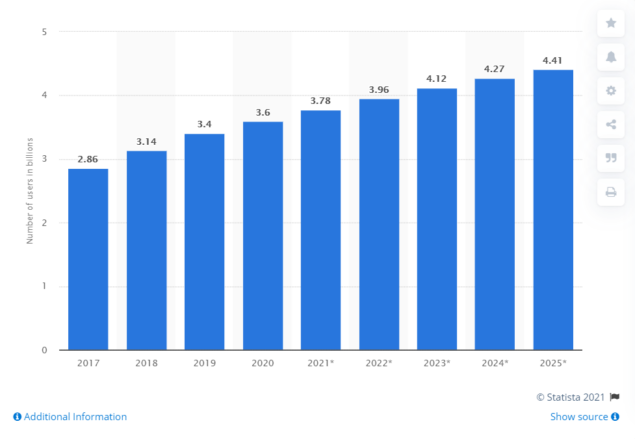
4.66 billion people around the world use the internet (DataReportal, 2021), and the number of worldwide social media users is expected to rise to nearly 4.41 billion by 2025 (Statista, 2021).
This growth is accelerated by less developed digital markets catching up with other regions in terms of infrastructure development and the availability of low-cost mobile devices.
Below, you can see year-on-year social networking user growth in selected countries in 2020 (Statista, 2021).
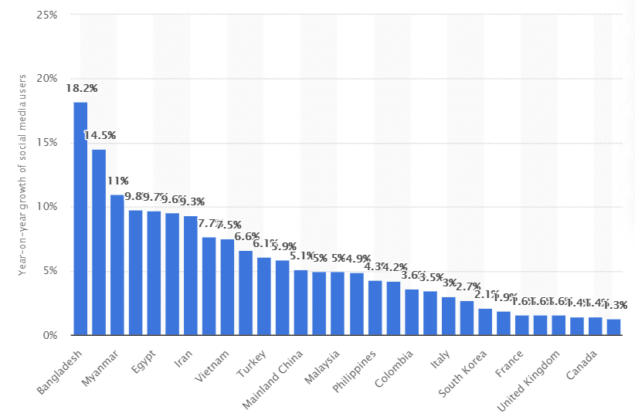
Bangladesh’s social media audience grew by 18.2% in 2020 compared to the previous year, making Bangladesh the world’s fastest-growing global social media market. In contrast, the number of people using social media in the United States rose by just 1.3%.
2. Social media growth is led by mobile
Social media’s global growth is mostly driven by the increasing usage of mobile devices. The graph below depicts the global mobile social network penetration rate by area as of January 2019.
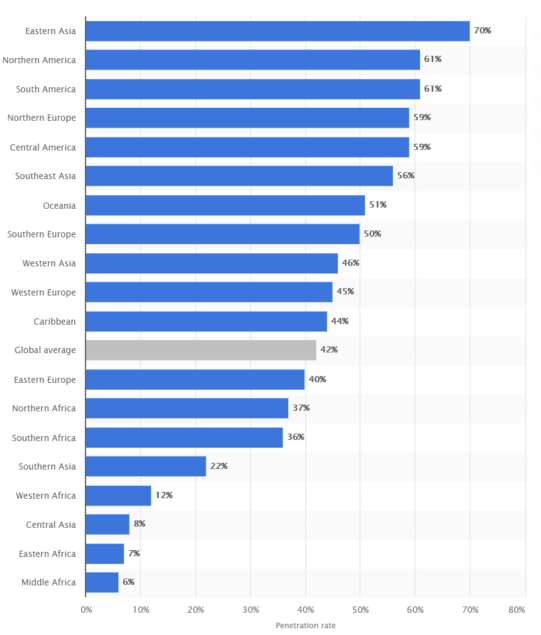
Mobile-first East Asia topped the global ranking with a mobile social media penetration rate of 70% at the time, followed by North America with a rate of 61% (Statista, 2019). The global penetration rate of mobile social media was 42%.
3. Facebook is the most popular social media channel
No matter what Gen Z may lead us to believe, Facebook remains the indisputable king of social media. It was the first to gather over 1 billion registered accounts and now has over 2.74 billion monthly active users (Statista, 2021).
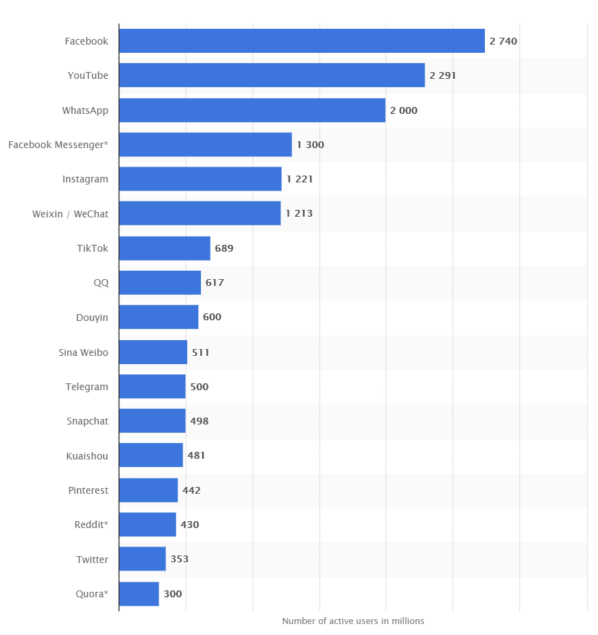
The Facebook family of apps and services owns four of the biggest social media platforms:
- Facebook Messenger
These platforms have over 1 billion monthly active users each, and all make it to the top 5, making Facebook the king of social media.
4. How much time do people spend on social media?
How much time would you say you spend scrolling your Facebook feed daily? 15 minutes? Half an hour? Many of us wish this were the case. However, in reality, we spend much more time on social media than we’d like to.
According to the latest statistics, we spend 2 hours and 25 minutes on social media on average each day (DataReportal, 2021).
When you think about it, these numbers make sense, especially if you’ve ever fallen into the rabbit hole of cute animal reels on Instagram. Because they’re good dogs, Brent!
5. Age demographics of social media users
Pew Research Center did a survey in 2021 to understand the age range for U.S. social media users and found this:
vizualas
- Millennials and Gen Z are the most active social media users. 84% of young US adults (aged 18-29) are active on social media.
- US Adults aged 30-49 use social media a little bit less – the number of active daily users falls to 81%. This group consists of older millennials and most of Gen X.
- The usage of social media further decreases with age. 73% of US adults aged 50-64 are on social media daily.
- Finally, only 45% of US adults aged 65 and above (baby boomers) are social media users.
Key social media platforms and their demographics in the U.S.
Here are the demographics for each social media platform.
Facebook statistics:
- Largest age group: 25-34 (25%), followed by 35-44 (18.3%), and 18-24 (15.8%) (source).
- Gender: 44% female, 56% male.
Instagram statistics:
YouTube statistics:
Twitter statistics:
TikTok statistics:
Since Millennials and Gen Z use social media the most and take a significant part of society, let’s take a little deeper look at their social media statistics.
What social media do millennials and Gen Z use the most?
Regardless of gender, YouTube was the social media for millennials and Gen Z among the U.S. internet users. In this survey, 95% of male respondents and 92% of female respondents said they used the online video platform. Facebook, on the other hand, had a 70 and 78 percent reach, respectively (Statista, 2021).

6. What are the fastest-growing social networks?
While Facebook has been the king of social media since forever, it doesn’t necessarily mean that it’s the fastest growing social network. In fact, Facebook’s growth rate has significantly slowed down since its early days.
Facebook’s daily active users’ growth rate was 41.41% from 2011 to 2012. However, as of 2021 Q1, it’s down to 11% (Statista, 2021).
While it may look like Facebook is losing its momentum, we need to remember its global size. After all, as we’ve seen earlier in this article, about half of the internet users worldwide already use this social network.
Enter TikTok.
While TikTok’s active daily users can’t compare with Facebook, this video-sharing app instantly became a worldwide phenomenon when it was launched in 2016.
TikTok boasts a massive growth rate.
The social network has accumulated 689 million monthly active users worldwide in under three years (DataReportal, 2021). To put it into context, Facebook was opened to the public in 2006 and reached 680 million monthly active users in Q1 2011 (Statista, 2021).
Also, TikTok was the most downloaded app on the Apple App Store for Q1 2019. The social network app was downloaded more than 33 million times.
7. How effective is social media marketing for businesses?
73% of marketers claim that their work with social media has been “somewhat effective” or “very effective,” and only 2.3% say that it’s been very ineffective (Buffer, 2019).

However, 19.1% of marketers said that they’re uncertain of social media’s effectiveness as a marketing channel.
This indicates that measuring social media efforts can still be an issue that needs to be addressed within marketing teams. One way to solve it is to use Google Analytics to see the holistic view of different marketing channels and compare their effectiveness against each other.
The answer to why 19.1% of marketers say that they can’t evaluate the effectiveness of their social media campaigns may also lie in the fact that as many as 50.9% of marketers claim that their company doesn’t have a documented social media strategy.

B. Social media and consumer behavior
Now that we’ve covered the essential social media statistics, let’s take a look at how social networks help businesses grow.
1. Social media users engage with brands
Long gone are the days when we only used Facebook or Instagram to see what our friends are up to. Today, people also turn to social media for purchase inspiration. Here are the findings from a recent research by GlobalWebIndex (2018).
- 54% of social browsers use social media to research products.
- 36% of social browsers follow a brand on social media.
- 19% of social browsers asked a question to a brand on social media.
- 15% of social browsers uploaded a photo/video to a brand’s social media page.
- 24% of social browsers clicked on a promoted/sponsored post on social media.
For businesses, having a strong online presence on different social media platforms is critical. Figure out which social media channels your target audience uses most often and put your money there. You can check our research of 60+k Shopify stores to see where buyers come from depending on your niche.
2. Actions consumers take when they follow a brand on social media
The Sprout Social Index 2020 reported that when consumers follow brands on social media platforms, they take the following actions:
- 91% of them visit the brand’s website or application
- 89% of them buy from that brand
- 85% of them recommend that brand to a family or friend
- 84% of them choose that brand over a competitor
- 84% of them visit the brand’s physical retail store
- 75% of them increase their spending with that brand
- 74% of them reach out for customer service or support
- 74% of them read that brand’s blog or site content
- 71% of them engage with that brand on social media
3. Great customer service on social media increases brand awareness
Today, consumers expect brands to provide customer service on their social media accounts. This includes replies to messages and responding to comments and mentions in posts or stories.
According to LyfeMarketing, 71% of consumers who have had a positive experience with a brand on social media are likely to recommend that brand to their friends and family.
Being responsive to your customers on social media is a must if you want to build great relationships with your customers and expand your brand awareness.
4. For Gen Z, social media is the primary channel for brand research
If your brand is targeting Gen Z, you should put your greatest efforts into your social media marketing.
As of January 2021, Gen Z internet users are more likely to begin their brand research on social media than on a search engine. 53.2% of Gen Z aged 16 to 24 begin their brand research on social networks (DataReportal, 2021).
It’s very likely that we’ll see the same tendencies in social media usage with younger millennials, too. Right now, for 48.2% of millennials aged 25 to 34 years old social media is the primary channel for brand research (DataReportal, 2021).
5. Instagram is leading in brand content interactions in the U.S.
In 2020, Instagram accounted for a whopping 67% of the 290 billion actions (likes, reactions, comments, shares, and retweets) on brand-owned content across Facebook, Instagram, and Twitter (Statista, 2021).
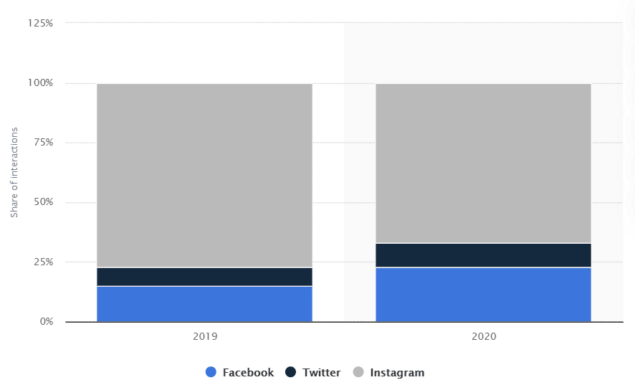
Though, if we’d look at the data from 2019, Instagram’s share of brand content interactions decreased by 10% (from 77% to 67%). Facebook, on the other hand, increased its share by 8% (from 15% to 23%). And on Twitter, people engaged with brands the least out of the big three social networks. Its share increased by 2% in 2020 (from 8% to 10%).
C. Social media content trends
Finally, let’s look at what kind of content on social networks works best with consumers.
1. Consumers prefer images on brands’ social media
The Sprout Social Index 2020 reported that 68% of consumers prefer to engage with images, while 50% want to engage with videos. 30% of people surveyed also said they like text-based posts.
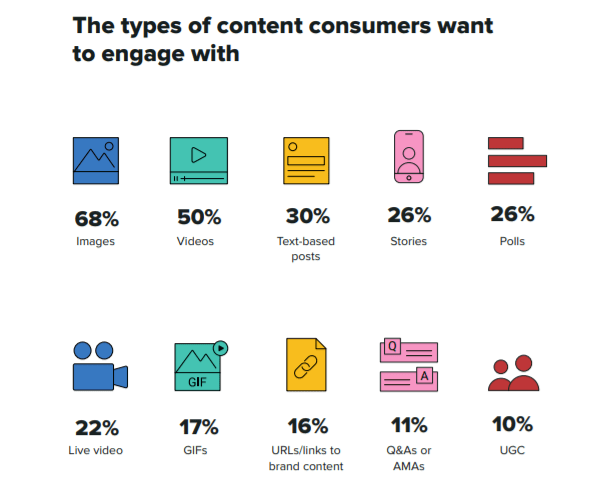
Only 10% of consumers want to engage with UGC content.
2. Instagram is the most important channel for influencer marketing
Instagram is the go-to social network for influencer marketing. With over 1 billion monthly active users (check #3 for more info), Instagram is the most important social media channel for 89% of marketers surveyed (Mediakix, 2019).
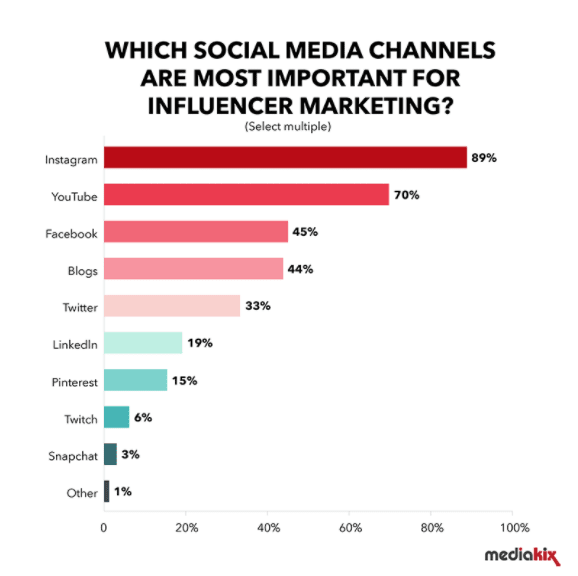
Other well-established social platforms, such as YouTube and Facebook, are also in the top three, important to 70% and 45% of surveyed marketers, respectively.
Still, most of the money goes to Instagram. 69% of marketers of the same survey said they would spend the most on Instagram for influencer marketing in 2019.
3. Gen Z follows influencers almost as much as brands
Influencer marketing should have a considerable part in social media marketing, especially if your brand is targeting the younger population, such as Gen Z.
The data from recent research by Global Web Index shows that influencers have a hold on Gen Z.
Out of Gen Zers who are on social media, 33% follow brands they purchase from/are considering purchasing from, and 28% follow influencers or other experts (Global Web Index, 2021).
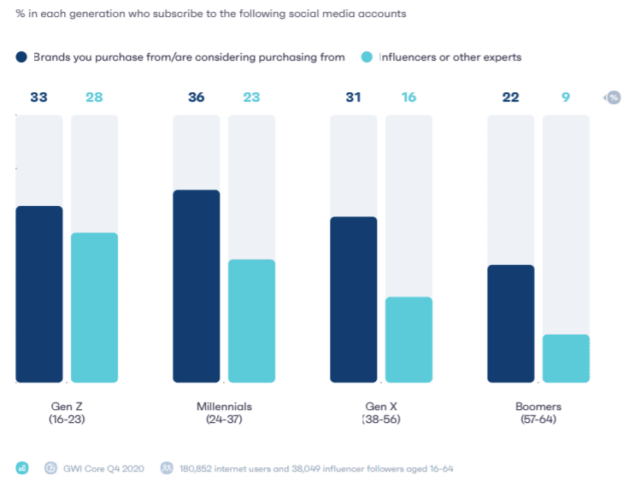
What Gen Z expects from influencer content on social media
Global Web Index explains that “influencers are a valuable tool to help brands engage with customers in a more human, empathetic, and personal way.” It’s important that influencers produce content that is more raw, unfiltered, something that people relate to better than glitzy backdrops.
Also, they add in their report that “Influencers that offer lifestyle tips and encourage people to open up and express their frustrations, while voicing their own, are best-placed to engage their followers in a meaningful way.”
4. Pinterest = product research
Around 4 in 10 Pinterest users log onto this social media platform to research brands and products (Global Web Index, 2021).
Since the pandemic, purchase, and lifestyle inspiration have been in high demand. Brands should turn to Pinterest to find their ideal shoppers.
Global Web Index explains that home décor, fashion, and food are the prevailing categories among Pinterest users. Women take more interest in these categories, whereas men take the lead in travel, fitness, and family inspiration. If you’re targeting people in these niches, keep these trends in mind when you need to plan content for Pinterest.
Social Media Marketing Statistics: Key takeaways
So, how does the social media landscape look in 2021?
- About 49% of the total global population uses social media (that is 3.6 billion people).
- Social media growth is led by mobile, especially in the less developed digital markets that are now catching up with others.
- Facebook is still the number one social media platform and now has over 2.74 billion monthly active users.
- On average, people spend 2 hours and 25 minutes on social media each day.
- Millennials and Gen Z are the most active social media users. 84% of young US adults (aged 18-29) are active on social media.
- YouTube is the most popular social media channel for millennials and Gen Z.
- TikTok is the fastest-growing social media platform.
- Social media marketing works! 73% of marketers claim that their work with social media has been “somewhat effective” or “very effective.
- 50.9% of marketers say that they don’t have a documented social media marketing strategy. This may be why 19.1% of marketers are uncertain if their social media marketing efforts pay off.
- 54% of social media users use social networks for product research.
- 89% of consumers who follow a brand will make a purchase from it.
- Great customer service on social media can increase brand awareness. 71% of consumers who have had a positive experience with a brand on social media say that they’re likely to recommend that brand to their friends and family.
- 53.2% of Gen Z aged 16 to 24 start their brand research on social media.
- People in the U.S. engage with brands the most on Instagram as compared to Facebook and Twitter.
- 68% of consumers prefer to engage with images when it comes to brand content. 50% want to engage with videos and only 30% with text-based posts.
- Instagram is the most important channel for influencer marketing for 89% of marketers.
- Gen Z follows influencers almost as much as brands (28% and 33% accordingly).
- Around 4 in 10 Pinterest users use this social network for brand and product research.
FAQ
What is social media marketing?
Social media marketing is the use of social networks, such as Facebook, Instagram, or TikTok, to connect with your target audience, get more website traffic, and increase sales. This entails creating engaging content on your social media accounts, interacting with your followers under comments and in private messages, and running social media ads.
How many people use social media?
According to the latest statistics, over 3.6 billion people currently use social media globally in 2020 (Statista, 2021). This equals to about 49% of the total global population.
Is social media marketing dead in 2021?
Social media marketing is not dead in 2021, but it’s evolving. While organic reach on social networks like Facebook has dropped, people still turn to social media to research products and connect with brands. With each year, popular social media platforms introduce more features that allow businesses to connect with their target audience in creative and authentic ways. Plus, advertising is getting increasingly advanced and allows brands to reach their potential customers where they hang out the most.
What percentage of marketing is social media?
According to Statista, in 2021, 91.9% of U.S. marketers in companies that have more than 100 employees expected to use social media for marketing purposes. In comparison, in 2013, the number stood at 86.2%
How big is the social media marketing industry?
Social media marketing industry is huge. According to Statista, Facebook’s revenue in 2019 amounted to 70.7 billion U.S. dollars. To put it in context, the online review company Yelp’s revenue was 1.01 billion U.S. dollars. Instagram’s annual revenue in 2019 was projected to reach 14 billion U.S. dollars.
Does social media marketing increase sales?
Social media marketing helps to increase sales in many ways. For one, just by being available on social networks and responding to messages, brands can clear out the doubts and encourage people to make a purchase. Plus, social media content that aligns with the values and aspirations of potential customers helps to build stronger connections and nurture loyal customers.rnrnFinally, if social media marketing wouldn’t increase sales, companies wouldn’t be investing so much money into it. According to Statista, Facebook’s total advertising revenue alone amounted to 25.4 billion U.S. dollars in the first quarter of 2021. The value of social media advertising is clear.



